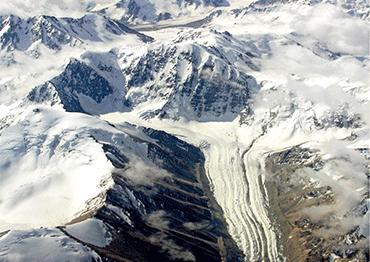Yahr Memet, 34, a herder who tends his flock in the Tianshan Mountains, has first-hand experience of how the climate is changing as he observes the effect on his livestock, mostly Alpine fine-wool sheep and cashmere goats. Living in Tacun Village in the foothills of Mount Tomur, the highest peak in the Tianshan range at 7,443 meters, he told NewsChina that he feels the number of high-temperature days has increased every year. His flock, normally active, are listless when temperatures are high, seeking shade and not bothering to eat.
But the increase in precipitation has improved some pastureland. “The grass grows well, and the sheep eat well,” said Tursun Tumur, manager of Xinjiang Tagerak Ecological Agriculture Company in Wensu County, Aksu Prefecture. Yahr Memet said the increase in summer rain has resulted in lush, better-quality grass. “Ten years ago, the grass was about 20 centimeters high. Now it’s 40 centimeters taller, and some grows past my knees,” Yahr said.
According to data from Wensu County, in 2014, vegetation coverage was 35.4 percent, but by 2022, it had increased to 39.2 percent, and the pasture has become significantly greener.
By midsummer, the pastures of Wensu are rich and verdant, with beads of moisture reflecting and refracting the sunlight. The dark green spruce forests are carpeted with Jerusalem sage, a perennial plant with broad leaves and small purple flowers. Mostly found in southeastern China and Southeast Asia, the plant used to be rare in this part of Xinjiang.
In September 2022, scientists found a new type of moss – Grimmia caoton-giana – in Mount Tomur National Park. It belongs to the group of plants known as bryophytes, which includes liverworts, hornworts and mosses. They are highly sensitive to changes in humidity, which can spur growth.
Tursun believes that biodiversity enrichment is a significant outcome of the changing climate, though he pointed out that other factors, such as a ban on grazing, had also had an effect.
Xinjiang Meteorological Bureau data shows an average temperature increase in Xinjiang of 1 C from 2001 to 2022 compared to the 1961-2000 average, and average precipitation increased by 25 millimeters, a rise of 16.1 percent. In the last decade, precipitation in southern Xinjiang increased by nearly 15 percent.
According to data from the CMA, the annual average temperature in Xinjiang from 1971 to 2000 was 7.8 C, and the annual average temperature warming rate from 1961 to 2010 was 0.32 C per 10 years, higher than the national and global change levels in the same period. The temperature rise in the eastern part of northern Xinjiang and the eastern Tianshan Mountains is more distinctive at 0.6-0.8 C per 10 years.
Ding Yihui, an academic who consults on the National Expert Committee on Climate Change, told NewsChina that warm Atlantic ocean currents have strengthened since the 1980s, and through the interaction of sea and air, the westerly air circulation is bringing in warmer and more humid air to northwest China. As the Arctic warms, cold air moves increasingly south, thus bringing a variety of vapor sources generated in the Arctic and the Pacific Ocean. Along with these sources of precipitation, scientists found that glacial meltwater and river runoff are major sources of water in northwest China. The trend in Xinjiang is a regional result of global climate change.
Yu Rucong, former deputy director of the CMA, told NewsChina that the Qilian Mountains, located between Qinghai and Gansu provinces, have a direct effect on precipitation processes, and as global warming intensifies the impact of the westerly prevailing wind belt from west to east, it increases convective precipitation as warm moist air rapidly rises, condenses, and falls, possibly as extreme rain or hailstorms.

 Old Version
Old Version




